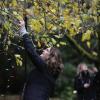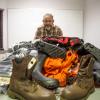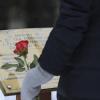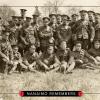
The Underwater Harvesters Association Grey Whale Exhibit was unveiled at VIU's Deep Bay Marine Field Station Tuesday, June 23. The inspiring scientific and educational exhibit, which hangs from the ceiling above the staircase, was created by a team of more than 100 volunteers.
June 24, 2015 - 4:45pm
The unveiling of a 10-metre long grey whale skeleton at Vancouver Island University’s (VIU) Deep Bay Marine Field Station was an emotional moment for Sharon Cooper of Sc’ianew First Nation.
Cooper first saw the body of the grey whale five years ago after it washed up at East Sooke Park near Victoria.
“I was so sad,” said Cooper. “People had carved their initials into the whale’s body, and huge chunks of blubber were removed. I knew that I had to save this whale. We had to leave a legacy for future generations and make a difference. This is something that I was supposed to do.”
On Tuesday night, Cooper’s vision became a reality. She joined more than 160 people – donors and volunteers – who gathered at VIU’s Deep Bay Marine Field Station for the grand unveiling of the Underwater Harvesters Association Grey Whale Exhale skeleton hangs from the ceiling as a grand centre piece on the main floor of the Field Station.
The unveiling also brought tears to the eyes of dozens of volunteers and donors who helped in time or money to bring the eye-catching educational exhibit to life during the past year.
“It’s really spectacular,” said Ken Magnus, a retired radiologist who alone put in more than 700 volunteer hours on the project. “It’s been an absolute pleasure working with the team who put this together. I retired two years ago at age 70 and was rattling around the house. This project filled the gap nicely. It’s been a godsend for me personally.”
After Cooper saw the body of the whale lying on the beach, she rallied support from her partner and a friend, as well as the Department of Fisheries and Oceans and VIU.
The whale’s body was towed from the beach to Sc’ianew First Nation land where it was respectfully buried. In 2014, after four years of decomposition, the whale’s bones were exhumed and transported to the Field Station.
Field Station Manager Brian Kingzett and VIU’s Advancement & Alumni Relations Office launched a unique “Raise the Whale” online fundraising campaign, and sold more than 160 bones to raise the $70,000 to cover the costs of creating the exhibit.
Kingzett hired Cetacea Contracting from Saltspring Island, who specialize in large mammal articulation projects. Owners Michi Main and Mike deRoos led a team of volunteers, including VIU students and community members, through the detailed process of cleaning and preparing the bones for the final exhibit.
Magnus said his knowledge of bones and anatomy from his long career as a radiologist “came in handy” for researching and identifying bones, bleaching them, and figuring out a way to put some of them back together.
There were several other core volunteers, including retired high school carpentry teacher Ross Walton, and Deb and Neale Wortley.
The Wortleys, who retired to Qualicum Bay from the Yukon, first heard about the project while enjoying High Tea By the Sea at the Field Station. Not only did they support the project financially by buying the whale’s $5,000 skull, they became avid volunteers.
“When you retire, you’re supposed to do something, so we thought ‘why not help build a whale?’ In the end, it all came together and was a lot of fun,” said Neale. “We met really interesting people by volunteering.”
“I did a lot of bone sculpting,” added Deb. “We needed the bones to look as natural as they could. Some pieces had broken or chipped off during the move from Beecher Bay to the Field Station, so we used modeling clay to touch them up. Some days, we spent eight hours working on one small piece of bone.”
Stephanie Richards, Facilities Coordinator at the Field Station, said more than 2,000 volunteer hours went into the project.
Walton added that volunteering on the whale articulation project filled his days with purpose for a great cause. “I heard about the project after reading an article in the local paper. I’ve been coming here to help out ever since.
“My role was to help wash the bones after they were removed from the burial site. I also drilled the bones to prepare them for the metal framework, which holds them together. The final exhibit is just incredible.”
Lead donors included the Underwater Harvesters Association (UHA), which donated $10,000 to the project for the naming rights, and Jamie’s Whaling Station and Adventure Centres of Tofino/Ucluelet, which purchased all 23 bones in the whale’s tale.
All donors received a certificate of bone ownership and an invitation to Tuesday’s unveiling ceremony.
Cooper added that the project wouldn’t have been possible without the vision, friendship and support of Kingzett, who was unable to attend the unveiling. “He deserves the credit for helping to spearhead the whole project,” said Cooper.
The public is invited to visit the Deep Bay Marine Field Station and see the whale exhibit first hand, and take in other activities such as High Tea by the Sea, Music by the Bay concerts and other special events.
The Field Station is open seven days a week, 10 am to 4 pm. Learn more about Deep Bay Marine Field Station
-30-
Media Contact
Janina Stajic, Manager, Vancouver Island University
P:250.740.6288 E: Communications@viu.ca
Tags: In the Community






